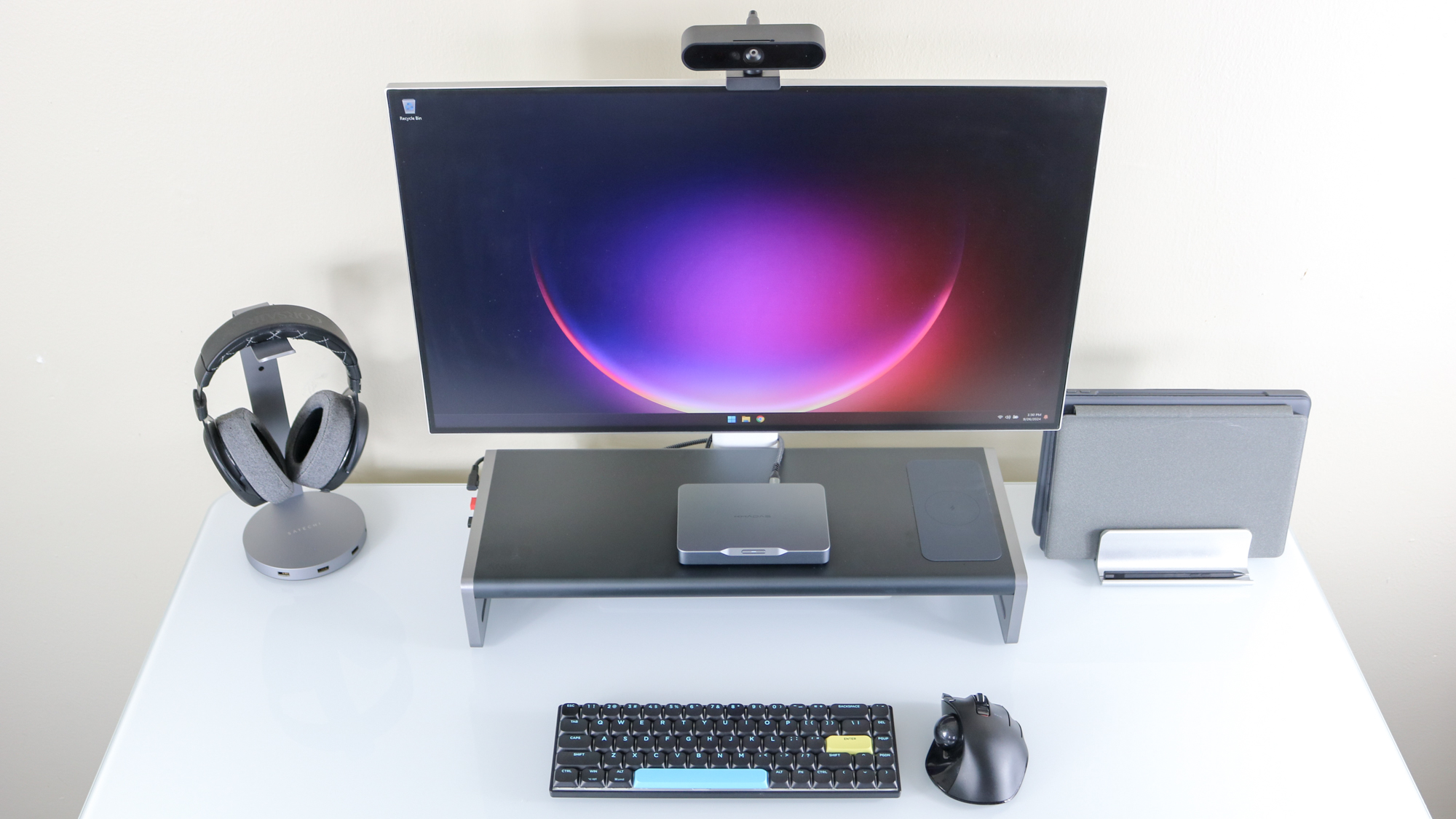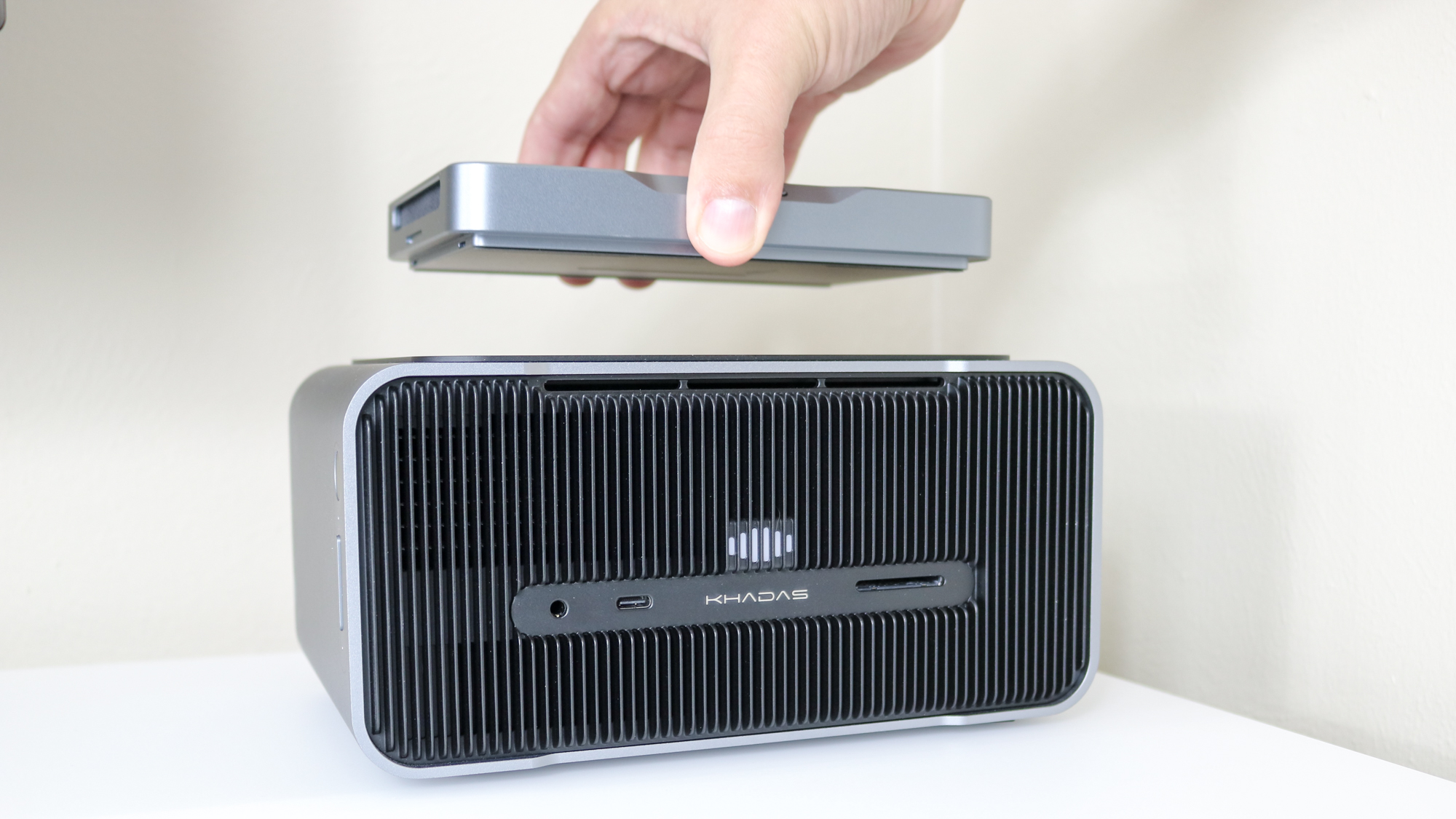Tom's Guide Verdict
The Khadas Mind is a pocketable mini PC that’s absolutely tiny. Even with its smaller size, it still features full-sized ports and enough power for most tasks. Thanks to its modular design, you can dock the Khadas Mind in either of the company’s docking stations for more ports and features, though like the device itself, they carry a premium price tag.
Pros
- +
Powered by USB-C
- +
Quiet and cool while in use
- +
Optional docks add extra ports/functionality
- +
Built-in battery lasts a day in standby mode
Cons
- -
Expensive
- -
Premium priced accessories
Why you can trust Tom's Guide
The Khadas Mind is an extremely portable and modular mini PC that looks more like an external hard drive than a computer. It sports a sleek anodized aluminum finish and still comes with full-sized ports despite its tiny size. The Khadas Mind is a capable mini PC on its own but you can add more ports, extra functionality and even a desktop-style graphics card with either of the company’s docks.
I was intrigued by the Khadas Mind when it was first announced but after testing the device for the past few months, it really feels like the future. Not only can you dock it but you can also slip it into your pocket, plug it in somewhere else and get right back to what you were doing thanks to its built-in 5.5Wh battery that’s advertised to last for up to 25 hours when the device is in sleep mode.
My Khadas Mind review will help you decide if this novel approach to computing is just a gimmick or if this pocketable computer is one of the best mini PCs you can get today.
Khadas Mind: Cheat Sheet
- What is it? A tiny, rectangular-shaped mini PC that’s small enough to fit in your pocket.
- Who is it for? People looking for a very portable mini PC they can bring with them and use at home as well as in the office.
- What does it cost? The standard Khadas Mind costs $649 while the premium version costs $899.
- What do we like? Its sleek, space-age design, how small it is, the built-in battery for hot-swapping, the spare M.2 SSD slot on the bottom and how you can add more ports as well as bolster its capabilities using either the standard or the graphics dock.
- What don’t we like? It’s priced slightly higher than other mini PCs due to its design and portability and the optional accessories carry a premium price tag as well.
Khadas Mind: Specs
| Header Cell - Column 0 | Khadas Mind Standard | Khadas Mind Premium (as tested) |
|---|---|---|
| Price | $649 | $899 |
| CPU | Intel Core i5-1340P | Intel Core i7-1360P |
| GPU | Intel Iris Xe Graphics | Intel Iris Xe Graphics |
| RAM | 16GB LPDDR5 | 32GB LPDDR5 |
| Storage | 512GB SSD (supports up to 2TB via M.2 2330 NVMe SSD slot) | 1 TB SSD (supports up to 2TB via M.2 2330 NVMe SSD slot) |
| Ports | 2x USB-C (one for power), 2x USB-A, 1x HDMI 2.0 | 2x USB-C (one for power), 2x USB-A, 1x HDMI 2.0 |
| Connectivity | Wi-Fi 6E, Bluetooth 5.3 | Wi-Fi 6E, Bluetooth 5.3 |
| Battery | Built-in 5.55Wh standby battery | Built-in 5.55Wh standby battery |
| Size | 5.75 x 4.13 x 0.79 inches | 5.75 x 4.13 x 0.79 inches |
| Weight | 1 pound (450 grams) | 1 pound (450 grams) |
Khadas Mind: The ups
From its sleek and modular design to the fact that it’s powered by USB-C instead of a barrel-port connector, there’s quite a lot to like about the Khadas Mind on its own. However, this mini PC becomes even more capable when magnetically attached to Khadas’ Mind Dock or Mind Graphics dock.
Slim enough for your pocket

At just 5.74 x 4.13 x 0.79 inches, the Khadas Mind is an absolutely tiny mini PC that manages to pack in plenty of power and full-sized ports. In fact, it’s even smaller — though just slightly wider — than Apple’s new Mac mini M4. Likewise, while the latest Mac mini still uses a standard AC plug for power, the Khadas Mind is powered via USB-C. It comes with a 65W power adapter but in my testing, I found that a GaN charger works just as well.

Even though the Khadas Mind is literally small enough to slip into your pocket, it comes equipped with two USB-A ports, two USB-C ports (one for power) and an HDMI 2.0 port. Surprisingly, when you flip it over, there’s even a free M.2 NVMe 2230 SSD slot in case you want to add extra storage. While the Standard model comes with a 512GB SSD, the Premium version has a 1TB SSD.
| Header Cell - Column 0 | Khadas Mind | Acemagic F2A |
|---|---|---|
| Geekbench 6.3 single-core | 2596 | 2271 |
| Geekbench 6.3 multi-core | 9261 | 11170 |
| 25GB file copy test (MBps) | 1706.42 | 1176.49 |
| Handbrake (Mins:Secs) | 7:23 | 4:41 |
The Khadas Mind comes equipped with either an Intel Core i5-1340P or Intel Core i7-1360P processor depending on which version you get. I tested the Premium model and in the benchmarks above, you can see it was able to hold its own (for the most part) against the more powerful Acemagic F2A mini PC which has a newer Intel Core Ultra 5 125H processor and a larger chassis at 5.79 x 5.79 x 2.05 inches.
A truly portable mini PC

The Khadas Mind is small enough to bring with you, and it has another trick up its sleeve that might make you consider doing so. Even though this is a mini PC and not one of the best laptops, it still has a built-in 5.5Wh battery. The Khadas Mind can be used with a portable monitor to work for 20 minutes or so but this isn’t why it has a battery. Instead, the built-in battery is designed for when the device is in sleep mode.

Although I work from home, I have several desk setups spread throughout my house since in addition to mini PCs, I also test and review the best standing desks. With the Khadas Mind, I was able to work on something in my office, disconnect it and then plug it into my Samsung M5 monitor in another room and quickly pick up right where I left off. I was also able to do all this with a single cable too since that monitor delivers 65W of power over USB-C.
From there, I set up Khadas’ two docks at different desks and did the exact same thing by magnetically docking and undocking the Mind. If your job lets you bring your own computer or you move between houses or apartments throughout the week, this feature alone could make the Khadas Mind a better choice over other mini PCs.
Docked and loaded

Although you can absolutely use the Khadas Mind on its own, this mini PC is even better when docked. Now I’m not talking about using it with your run-of-the-mill laptop dock or even a multi-purpose dock like the Anker 675 USB-C charging station.
Khadas has two different docks you can magnetically attach it to: the standard Mind Dock with more ports, a fingerprint reader, an SD card reader, a volume knob and support for multiple displays, or the much beefier Mind Graphics Dock that adds a Nvidia RTX 4060 Ti graphics card, built-in speakers and a slew of additional ports at the back.

The Mind Dock adds an extra USB-A port, an SD card reader and a 3.5mm audio jack up front along with a fingerprint reader on the left for Windows Hello and even a volume knob on the right. On the back, you get another USB-C port (for power), two USB-A ports, two HDMI ports and an Ethernet port. Besides the extra ports and support for multiple displays, I really liked the fingerprint reader and the volume knob on the Mind Dock as they both make interacting with your mini PC a bit easier.

If you want to turbocharge the Khadas Mind though, then the Mind Graphics dock is what you need. It features a Nvidia RTX 4060 Ti desktop GPU — with either 8GB or 16GB of VRAM — and even more ports than the much smaller Mind Dock.
On the front, there’s a 3.5mm audio jack, a USB-C port and an SD card reader along with a splash of customizable RGB lighting right above the logo. On the right side, there’s also a fingerprint reader and volume controls for its built-in, dual speaker system. It also has a built-in far-field microphone array for those times when you’d rather talk to your computer instead of typing.
| Header Cell - Column 0 | Khadas Mind | Khadas Mind with Mind Graphics |
|---|---|---|
| Civilization VI: Gathering Storm | 23 | 141.710 |
| Borderlands 3 | N/A | 110.80 |
| Shadow of the Tomb Raider | N/A | 120 |
| Total War: Warhammer III | N/A | 95.6 |

With the Khadas Mind magnetically attached to the Mind Graphics dock, the gaming performance boost is immediately apparent. In Civilization VI: Gathering Storm where the mini PC managed just 23 fps on its own, the frame rate jumped up to 141 fps when docked. Borderlands 3, Shadow of the Tomb Raider and slightly older titles ran well above 100 fps.
Even if you don’t plan on playing games, the Mind Graphics dock could be a worthwhile accessory if you plan on editing photos or video or doing other more demanding tasks that require a discrete GPU. You also get more ports on the front and back and additional power since unlike the Mind Dock, it uses a standard AC plug for power.
Khadas Mind: The downs
The Khadas Mind is the most unique mini PC I’ve tested yet. However, it’s not without drawbacks, like its higher price compared to other similarly specced mini PCs and the fact that the Mind Dock and Mind Graphics dock use Khadas’ proprietary Mind Link connector which means you’re buying into an ecosystem.
Paying a premium for portability
At $649 for the standard model and $899 for the premium one, the Khadas Mind is more expensive than similarly specced mini PCs. This makes sense though as it’s a much smaller device and sourcing components for it is likely more difficult too. At the same time, the Khadas Mind also has a more premium anodized aluminum finish while many other mini PCs use plastic for their cases.
If portability and modularity aren’t your top priorities, you may want to consider the Acemagic F2A or even the Mac mini if you prefer macOS over Windows. Likewise, if you have the budget for the Khadas Mind and the Mind Graphics Dock, you could get either the AtomMan G7 PT or the Asus ROG NUC 970 for slightly more.
It’s also worth noting that Khadas is preparing to launch the Mind 2 after revealing it earlier this year. This new version of the company’s pocketable PC features Intel’s Core Ultra CPUs and in addition to a standard and premium version, there’s also a configuration that pairs an Intel Core Ultra 7 with a whopping 64GB of RAM.
Buying into an ecosystem

If you buy a standard laptop dock like the Plugable TBT4-UD5 or the Ugreen Revodok Max 313, you’ll be able to use it with any laptop or mini PC. However, the same can’t be said about Khadas’ docking stations. While you can use the Mind Graphics dock with any laptop or PC via Thunderbolt, the same can’t be said for the Mind Dock. This is because it uses Khadas’ proprietary Mind Link connector and not USB-C.
So far, Khadas is still going strong after launching in 2016 which means the company won’t be going anywhere anytime soon. However, if it does and you invested heavily into the Mind Family ecosystem, you might be stuck with peripherals that don’t work with any of your other devices. Likewise, you could put together something similar performance-wise to the Mind Graphics dock on your own but it won’t look nearly as good. In the end, the choice is yours but it’s still something to consider.
Khadas Mind: Verdict
The Khadas Mind is truly a unique mini PC and in a way, it reminds me of the Framework Laptop. While it’s a capable little computer on its own, it’s even more useful when paired with either the Mind Dock or Mind Graphics Dock. Khadas is also working on a tablet dock you can slip the Mind into and I wouldn’t be surprised if we saw a laptop version down the line. If you’re looking for the most portable mini PC possible and want the option to expand its capabilities after the fact, the Khadas Mind is a great option and the Mind 2 looks to be an even better — though more expensive one — when it launches this year.
If portability or size aren’t that important to you though, you can get a more powerful mini PC for less. However, you’d be hard pressed to find one that looks as good as the Khadas Mind and uses USB-C for power instead of a bulky barrel-port connector.

Anthony Spadafora is the managing editor for security and home office furniture at Tom’s Guide where he covers everything from data breaches to password managers and the best way to cover your whole home or business with Wi-Fi. He also reviews standing desks, office chairs and other home office accessories with a penchant for building desk setups. Before joining the team, Anthony wrote for ITProPortal while living in Korea and later for TechRadar Pro after moving back to the US. Based in Houston, Texas, when he’s not writing Anthony can be found tinkering with PCs and game consoles, managing cables and upgrading his smart home.

